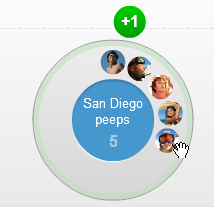How Does Google’s New Social Network Measure Up?
When Google introduced +1 earlier this year I called it “social search without a social network”. Now it’s bringing the social network, in the form of Google Plus.

You can take Google’s tour of the new features to find out more, and stay tuned for more coverage later. But, for now, here’s a quick score card comparing what’s been revealed of Google Plus so far with the social products already in use by millions of people.
At-a-glance-updates
Facebook wins, Google Plus loses.
The Facebook newsfeed triggered protests when introduced but now dominates the digital lives of hundreds of millions of people and the design of every social product since. Google is no exception, and it’s attempting to beat the canonical newsfeed by introducing two of them.
One provides the usual updates on friends’ activity. The other, called “Sparks”, grabs stuff from around the Web that matches with your stated interests. It’s a new idea, but a double-headed news feed seems too complex for a product that desperately needs to win users.
Organizing friends
Google Plus wins, Facebook and Twitter lose.

Accidental oversharing is an inherent risk of all social networks and Google’s solution looks to be the best yet.
Facebook and Twitter focus on a central list of friends carved into groups or lists that are hard to manage. Google’s focus is instead on “circles”, groups of people that you curate by dragging and dropping contacts. You can also add email contacts not using Google Plus and, most crucially, you can very easily isolate, say, your boss or relatives from more personal activities. Solving this issue could encourage heavier use of Google’s social platform; the risk of accidental oversharing certainly limits how people use Facebook and Twitter.
Video and voice
Google Plus wins, Skype loses.

A feature called Hangout enables private or group video calls right in the browser. Google uses its own video browser plugin (surely to be soon built into Chrome), sidestepping Adobe Flash and Skype. There’s neat tech built in, too, that automatically puts the video feed from the person talking center stage.
Mobile sharing and socializing
Google wins, everyone else loses.
Google has something no other social company does: a blockbusting mobile operating system. Two features shown off so far enable SMS-style messaging with nearby contacts and “instant upload” of any photo you take to Google Plus. There’s surely a lot more to come on this front. Android offers impressive support for social apps such as Facebook and Twitter, but Google is in a position to put its own social features front and center in future releases.
Ease of use
Twitter and email win, Google Plus loses.
Simplicity (Twitter) and familiarity (email) matter a lot when it comes to how people choose to spend their time. Google certainly knows that, having won the battle for search with an emphasis on a stripped down, simple experience. Yet the company claims the new social features unveiled today are just the tip of the iceberg. Finding on-ramps for people to get to know this sprawl of new ideas will be Google’s biggest challenge.
Keep Reading
Most Popular
Large language models can do jaw-dropping things. But nobody knows exactly why.
And that's a problem. Figuring it out is one of the biggest scientific puzzles of our time and a crucial step towards controlling more powerful future models.
The problem with plug-in hybrids? Their drivers.
Plug-in hybrids are often sold as a transition to EVs, but new data from Europe shows we’re still underestimating the emissions they produce.
Google DeepMind’s new generative model makes Super Mario–like games from scratch
Genie learns how to control games by watching hours and hours of video. It could help train next-gen robots too.
How scientists traced a mysterious covid case back to six toilets
When wastewater surveillance turns into a hunt for a single infected individual, the ethics get tricky.
Stay connected
Get the latest updates from
MIT Technology Review
Discover special offers, top stories, upcoming events, and more.